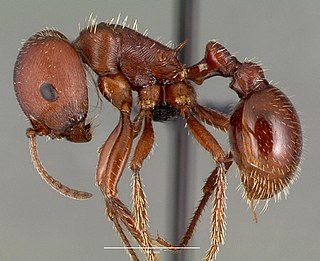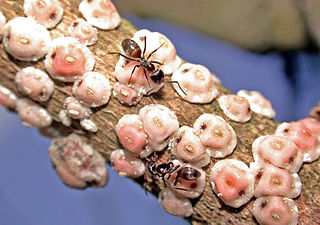
Pogonomyrmex is a genus of harvester ants, occurring primarily in the deserts of North, Central, and South America, with a single endemic species from Haiti.

Dolichoderinae is a subfamily of ants, which includes species such as the Argentine ant, the erratic ant, the odorous house ant, and the cone ant. The subfamily presents a great diversity of species throughout the world, distributed in different biogeographic realms, from the Palearctic, Nearctic, Afrotropical region and Malaysia, to the Middle East, Australian, and Neotropical regions.

Amyrmex golbachi is a rare Neotropical species of ant and the only known species in the genus Amyrmex. It is currently only known from males from the Amazon basin of Brazil and from northern Argentina.

Dorymyrmex is a genus of ants in the subfamily Dolichoderinae.

Leptomyrmecini is a tribe of Dolichoderinae ants with 16 genera and two extinct genera.
Forelius albiventris is a species of ant in the genus Forelius. Described by Forel in 1912, the species is endemic to South America.
Forelius bahianus is a species of ant in the genus Forelius. Described by Cuezzo in 2000, the species is endemic to Brazil.

Forelius brasiliensis is a species of ant in the genus Forelius. Described by Forel in 198 the species is endemic to South America.
Forelius breviscapus is a species of ant in the genus Forelius. Described by Forel in 1914, the species is endemic to Argentina.
Forelius chalybaeus is a species of ant in the genus Forelius. Described by Emery in 1906, the species is endemic to Argentina.
Forelius grandis is a species of ant in the genus Forelius. Described by Forel in 1912, the species is endemic to Argentina.
Forelius keiferi is a species of ant in the genus Forelius. Described by William Morton Wheeler in 1934, the species is endemic to Mexico.
Forelius lilloi is a species of ant in the genus Forelius. Described by Cuezzo in 2000, the species is endemic to Argentina.
Forelius macrops is a species of ant in the genus Forelius. Described by Kusnezov in 195, the species is endemic to Argentina.
Forelius maranhaoensis is a species of ant in the genus Forelius. Described by Cuezzo in 2000, the species is endemic to Brazil.

Forelius mccooki is a species of ant in the genus Forelius. Described by McCook in 1880, the species is endemic to the United States and Mexico, where they nest in soil surrounded by a typically small mound, and also nests under stones.

Forelius nigriventris is a species of ant in the genus Forelius. Described by Forel in 1912, the species is endemic to South America.

Forelius pusillus is a species of ant in the genus Forelius. Described by Santschi in 1922, the species is endemic to South America.
Forelius rubriceps is a species of ant in the genus Forelius. Described by Gallardo in 1916, the species is endemic to Argentina.
Forelius rufus is a species of ant in the genus Forelius. Described by Gallardo in 1916, the species is endemic to Argentina and Bolivia.









